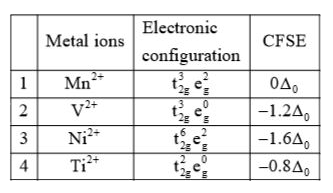Alum is found to contain hydrated monovalent cation [M(H2O)6]+ trivalent cation [M'(H2O)6]+ and SO3−4 in the ratio of:
1:1:1
1:2:3
1:3:2
1:1:2
The correct Answer is:D
To solve the problem regarding the composition of alum, we need to analyze the components given in the question. Here’s a step-by-step breakdown of the solution:
Step 1: Understand the Components of Alum
Alum is a type of double salt that typically contains:
- A hydrated monovalent cation, represented as (M(H₂O)₆)⁺
- A trivalent cation, represented as (M'(H₂O)₆)³⁺
- The sulfate ion, represented as SO₄²⁻
Step 2: Write the General Formula
The general formula for alum can be expressed as:
\( M_2SO_4 \cdot M'_{2(SO_4)} \cdot 24H_2O \)
This indicates that there are two monovalent cations (M), two trivalent cations (M'), and sulfate ions.
Step 3: Identify the Ratio of Ions
From the general formula:
- The number of monovalent cations (M) = 2
- The number of trivalent cations (M') = 2
- The number of sulfate ions (SO₄²⁻) = 4
Step 4: Simplify the Ratio
Now, we can express the ratio of the cations and sulfate ions:
- Ratio of M : M' : SO₄ = 2 : 2 : 4
To simplify this ratio, we divide each term by 2:
- M : M' : SO₄ = 1 : 1 : 2
Step 5: Conclusion
Thus, the final ratio of the hydrated monovalent cation, trivalent cation, and sulfate ion in alum is:
\( \text{Ratio} = 1 : 1 : 2 \)
Final Answer
The ratio of hydrated monovalent cation (M(H₂O)₆)⁺, trivalent cation (M'(H₂O)₆)³⁺, and sulfate ion SO₄²⁻ in alum is 1 : 1 : 2.
---
Alum is a type of double salt that typically contains:
- A hydrated monovalent cation, represented as (M(H₂O)₆)⁺
- A trivalent cation, represented as (M'(H₂O)₆)³⁺
- The sulfate ion, represented as SO₄²⁻
The general formula for alum can be expressed as:
\( M_2SO_4 \cdot M'_{2(SO_4)} \cdot 24H_2O \)
This indicates that there are two monovalent cations (M), two trivalent cations (M'), and sulfate ions.
From the general formula:
- The number of monovalent cations (M) = 2
- The number of trivalent cations (M') = 2
- The number of sulfate ions (SO₄²⁻) = 4
Now, we can express the ratio of the cations and sulfate ions:
- Ratio of M : M' : SO₄ = 2 : 2 : 4
- M : M' : SO₄ = 1 : 1 : 2
Thus, the final ratio of the hydrated monovalent cation, trivalent cation, and sulfate ion in alum is:
\( \text{Ratio} = 1 : 1 : 2 \)
The ratio of hydrated monovalent cation (M(H₂O)₆)⁺, trivalent cation (M'(H₂O)₆)³⁺, and sulfate ion SO₄²⁻ in alum is 1 : 1 : 2.
Topper's Solved these Questions
- BOOK - RESONANCE ENGLISHCHAPTER - P-BLOCK ELEMENT (BORON AND CARBON FAMILY)EXERCISE - Exercise-2 Part-I : ONLY ONE OPTION CORRECT TYPE26videos
P-BLOCK ELEMENT (BORON AND CARBON FAMILY)
- BOOK - RESONANCE ENGLISHCHAPTER - P-BLOCK ELEMENT (BORON AND CARBON FAMILY)EXERCISE - Exercise-2 Part-II : SINGLE AND DOUBLE VALUE INTEGER TYPE23videos
P-BLOCK ELEMENT (BORON AND CARBON FAMILY)
- BOOK - RESONANCE ENGLISHCHAPTER - P-BLOCK ELEMENT (BORON AND CARBON FAMILY)EXERCISE - Exercise-1 Part-II : ONLY ONE OPTION CORRECT TYPE Section (F) : Oxides, Oxyacids & Hydroxides ; Borax10videos
P-BLOCK ELEMENT (BORON AND CARBON FAMILY)
- BOOK - RESONANCE ENGLISHCHAPTER - P BLOCK ELEMENTSEXERCISE - PART -II23videos
P BLOCK ELEMENTS
- BOOK - RESONANCE ENGLISHCHAPTER - P-BLOCK ELEMENTS (HALOGEN & NOBLE GASES)EXERCISE - APSP PART-322videos
P-BLOCK ELEMENTS (HALOGEN & NOBLE GASES)
Similar Questions
[Sc(H2O)6]3+ ion is :-
View Solution[Co(H2O)6]3+ complex is
View SolutionSelect incorrect match for [M(H2O)6]2+ complex.
 View Solution
View Solution(a) [BeF4]2− exits, but [BeCl6]4− does not. Give reson.
(b). Hydrated beryllium ion exists as [Be(H2O)4]2+, whereas hydrated magnesium ion exists as [Mg(H2O)6]2+. Give reason.View SolutionIn the reaction: [Cu(H2O)3(OH)]++[AI(H2O)6]3+→[Cu(H2O)4]2++[AI(H2O)5(OH)]2+
View SolutionArrange the following complexes in order of increasing crystal field splitting .
[Fe(H2O)6]2+,[Fe(H2O)6]3+,[FeCl6]4− .View SolutionThe charing product formed when C6H12O6 is heated with cone, H2SO4 is due to:
View SolutionHow many electrons are present in t2g set of d-orbitals of central metal cation in [Fe(H2O)5(NO)]SO4 brown ring complex?
View SolutionH4S2–––O6+H2O→H2SO3+H2SO4
View SolutionH4S2–––O6+H2O→H2SO3+H2SO4
View Solution

